MyHimalayasimpressions from |
|
|||||||
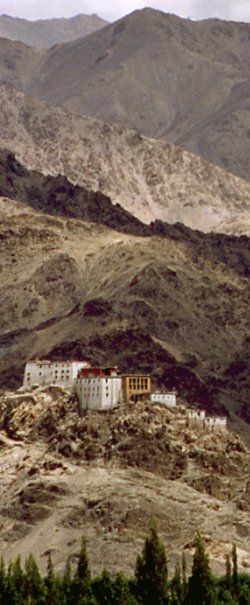
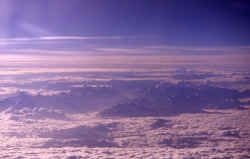
View from Delhi to Leh out of the right side towards the east - Garhwal Himal and Nanda Devi must be somewhere there.
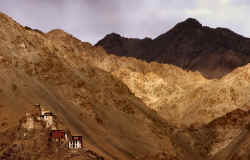
The old fort and monastery of Leh are a reminder of the town's central location in the Silk Route's southern branch.
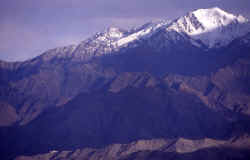
The only Shakya monastery in Ladakh is situated on a ridge connected to the dark ranges.
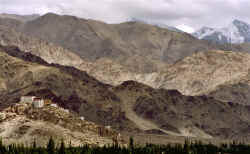
In the fertile Indus valley, dozens of monasteries were built on commanding positions.
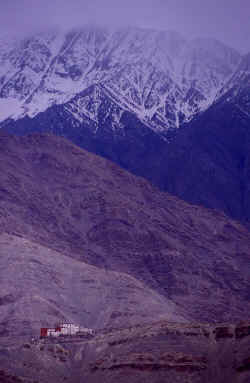
Mathok monastery stands out against the monsoon clouds that make it over the Ladakh range.
Likir: Leh and Indus Valley
Delhi - Leh - Indus Valley
20 June 2004 Delhi - Leh (Day 1)
Yesterday it was very cloudy so I didn’t see much during the flight from Sikkim to Delhi. Getting from the Delhi domestic airport to Hotel Metropolis turned out to be a major mission. First there was no pick-up, when the taxi-driver arrived an hour later I realized he has no clue as to where the hotel is. Or who knows, maybe he pretends not to know because he’s paid per minute of driving. Surely enough I do get to experience Delhi's rush hour at its best: narrow roads which are too small for two way traffic already, and are further narrowed by parked cars. As if things weren't hectic enough, the monsoon downpour starts instantly, increasing the chaos in the streets even more. I'm in the car enjoying a spectacle and feeling very relaxed (but only because I've been here before, know that I won't have to pay or argue with the taxi driver, and will get to the hotel eventually). Near the central bus station the activity gets even busier, it's brimming with colour, noise and smells. I'm not in the mood to experience this from too close, so I stay in the hotel. Just as the Euro soccer championship starts, the TV dies. At least I get some hours of sleep.
A few hours after midnight I get up, pack my things and after twenty minutes of driving in deserted streets arrive at the domestic airport. I check in and get a right-window seat, hoping to see Tso Moriri and the mountains of Garhwal and Kumaon. Left side seats reveal better views, but I sat there two years ago, and want to see the mountains I’ve read about in Shipton's and Tilmann's books.
Dark clouds gather over Delhi, the first half hour they hide everything. Then, far away to the east, the first peaks rise above the clouds. An impressive massif with many peaks - on of them probably Nanda Devi - appears, further away an even taller mountain dominates the horizon. Could this be Gurla Mandatha, the 7'728m high peak between Nepal, India and Tibet?
The valley of Spiti just below us is hidden by a thin layer of fog which persists until we reach the Indus valley far in the north. I do love the Ladakhi scenery and its stark contrasts, but from the airplane the scene of utter desolation is intimidating. Jagged mountains and mangled layers of rocks rise in an endless succession behind each other. Desert-like valleys look inhospitable, and the grey clouds increase the feeling of an unforgiving harshness. Patches of green cover at the end of some valleys, but they're too far and between to change the overall effect.
After a long curve we descend into the Indus valley, Spituk monastery passes by on the right side and the plane lands safely. Compared to Nepali airstrips this is not very exciting, and I am happy about that.
Due to warm temperatures in Leh, the pilot decided that he cannot take the entire load of luggage. Therefore it’s with some anticipation that I wait for my duffel bag as piece by piece is passes by. Mine is the last to come. I don’t know if it’s the thin air that slows people down, locals as well as tourists. The atmosphere is very relaxed without any pushing or shoving or other sign of hurry – what a contrast to „mainland“ India.
Wangchuk, last year’s driver, is waiting to pick me up. On the way to the guesthouse we have a pleasant little chat, and I tell him to come tomorrow for a drive to some monasteries. Even though it’s the high season and the festival of Hemis will attract even more people, Wangchuk is not very happy about business. There is an influx of taxi drivers, he complains. I stay in Tongspon guesthouse near the center, take a nap and wake up an hour later by a loud discussion of some Israelis who stay in the same guesthouse.
After some shopping I walk up the Shanti Stupa. Exerting yourself in the first day at altitude is a bad idea, but I take my time. The many steep steps at altitude force me to stop a few times, and enjoy the fine views. The main town and the green suburb of Changspa lie below. Dark clouds loom over the barren peaks; it illuminates the ones where the sun breaks through the thick cover, the other ranges are completely black. The fort that overlooks the ancient trading town stands out even more commanding than on nice days.
I go to bed early and set the alarm to midnight: Spain – Portugal is a decisive match. I found a restaurant nearby where the owner told me „yes, we show all the matches.“ The front-door is locked. I knock, and nobody is there except some kitchen crew who are already sleeping on the floor. But I do get to watch the game with the Tandoori cook and some Tibetan kitchen boys. The entire town is asleep by the time the game is finished. Luckily the stray dogs have better things to do than attack me when I walk back to my hotel at 2 in the morning.
Leh – Shey – Matok (Day 2)
After a relaxing sleep I stroll around the old part of Leh. At noon I meet Wangchuk for some sightseeing in the Indus valley. I have enough time before meeting the group for the Nubra trek, so I could have taken the public bus also. But it’s nice to have company, and Wangchuk is a very knowledgeable and good guy.
First we drive to Shey, the ancient capital. It was the seat of the king before he moved it to Leh. Being at the foot of the pass which leads to Nubra and ultimately Central Asia, Leh was a better spot to control the trade. It seems that the seat of the ruler moved quite often, from Basgo to Shey to Leh to Stok. Renovation of the palace is under way and most rooms of the gompa are locked. A large statue is displayed but the atmosphere is not very solemn. I climb the hill behind the compound to get a better view over the valley. The valley floor is stunningly fertile; large patches of grass grow between poplars which contrast sharply with the gentle arid slopes and side alleys that lead up to the barren crags and mountains. When the clouds break, snow-capped 6'000 m peaks are revealed. Various monasteries are built on the hills which overlook the Indus,
One of them, across the Indus at the foot of the high Zanskar range, is Mathok, the only monastery in Ladakh which belongs to the Sakya order. Like the others it was built above the village and fertile fields, but is built on a ridge and not an isolated hill. The monastery is famous for its festival, harvest protection ceremony and corn silos. The top-most room is called Room of Oracles and its floor is covered by inches of corn. Every year more is added to bless the fields, and the story goes this tradition was abandoned once but quickly picked up again after a meager harvest in the following year. Monks recite prayers, and the grim statues which covered by cloth and old weapons tied to the pillars do create an errie atmosphere.
We drive back to Leh on the left side of the river, and enjoy the views of Thikse and Shey. Low hanging clouds move along the mountains, but except for a slight drizzle the weather is fine.
|
Summary Part 1:
Delhi is hectic as always, and I'm glad to get out in the early morning. It's cloudy so the views during the one-hour flight are not spectacular, only the silhouettes of the Garhwal range rise above the fog. The barreness of the landscape is accentuated by the green barley fields and flowers in its lush valleys. I visit some of the dozens of monasteries in the area, tough they seem similar each has little interesting details that the others don't. |